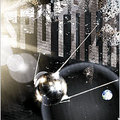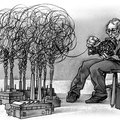
Charles Platiau/Reuters
VANITY OR ART A Dior show in Paris in February. New York Fashion Week begins on Tuesday.
DEPENDING on who is doing the talking, fashion is bourgeois, girly, unfeminist, conformist, elitist, frivolous, anti-intellectual and a cultural stepchild barely worth the attention paid to even the most minor arts.
With Fashion Week beginning in New York on Tuesday — the start of a twice-yearly, monthlong cycle of designer presentations on two continents and in four cities that will showcase hundreds of individual designers — it is worth asking why fashion remains the most culturally potent force that everyone loves to deride.
“Everyone” is not here intended to imply the deeply initiated, those pixie-dust people for whom the shape of a dress or the cut of a sleeve is a major event. There is certainly a place for those types, whether they are cuckoos like the late fashion editor Diana Vreeland (who once wrote, “I’m told it’s not in good taste to wear blackamoors anymore, but I think I’ll revive them”), or extravagant mythomaniacs like John Galliano, the Dior designer — who plays a pirate one season, a gypsy the next — or even the young celebrity brand pimps who would probably be offering paparazzi a lot more gratuitous crotch shots if designers didn’t provide them with free clothes.
No, everyone means the rest of us, those who scorn fashion outright and those who don’t but who nevertheless have the uneasy sense that this compelling world of surfaces and self-presentation is unworthy of regard.
“There is this suggestion that fashion is not an art form or a cultural form, but a form of vanity and consumerism,” said Elaine Showalter, the feminist literary critic and a professor emeritus at Princeton. And those, Ms. Showalter added, are dimensions of culture that “intelligent and serious” people are expected to scorn.
Particularly in academia, where bodies are just carts for hauling around brains, the thrill and social play and complex masquerade of fashion is “very much denigrated,” Ms. Showalter said. “The academic uniform has some variations,” she said, “but basically is intended to make you look like you’re not paying attention to fashion, and not vain, and not interested in it, God forbid.”
When Valerie Steele, the director of the museum at the Fashion Institute of Technology in New York, declared an interest at Yale graduate school in pursuing the history of fashion, colleagues were horror-struck. “I was amazed at how much hostility was directed at me,” Ms. Steele said. “The intellectuals thought it was unspeakable, despicable, everything but vain and sinful,” she added. She might as well have joined a satanic cult.
And that, substantially, is how a person still is looked at who happens to mention in serious company an interest in reading, say, Vogue.
“I hate it,” Miuccia Prada once remarked to me about fashion, in a conversation during which we mutually confessed to unease at being compelled by a subject so patently superficial.
“Of course, I love it also,” Ms. Prada added, and her reason said a lot about why fashion is a subject no one should be ashamed to take seriously. “Even when people don’t have anything,” Ms. Prada said, “they have their bodies and their clothes.”
They have their identities, that is, assembled during the profound daily ritual of clothing oneself; they have, as Colette once remarked, their civilizing masks. And yet, despite its potential as a tool for analyzing culture, history, politics and creative expression; as a form of descriptive shorthand used through all of written history (including the Vedas, the Bible and the Koran); as a social delight, fashion is just as often used as a weapon, a club wielded by those who forget that we are saying something about ourselves every time we get dressed — not infrequently things that fail to convey the whole truth.
Why else was Hillary Rodham Clinton’s campaign moved to attack the fashion critic of The Washington Post for attempting to read the candidate’s clothes? The editorial blitz that followed Senator Clinton’s outraged response to some blameless observations about a slight show of cleavage on the Senate floor was instructive, as was Mrs. Clinton’s summoning up of feminist cant about the sexism of focusing on what a woman wears to the exclusion of her ideas.
But clothes are ideas; to use a fashionism — Hello! Scholars like the art historian Anne Hollander have spent decades laying out the way that costume serves to billboard the self. One would have thought that few people understand this truth as well as the woman occasionally known as Hairband Hillary, who, after all, assiduously recast her image from that of demure and wifely second-banana to power-suited policy wonk, dressed to go forth and lead the free world.
Politicians are far from the only people who act as though the concerns of fashion are beneath consideration. When the Italian film legend Michelangelo Antonioni died recently, film critics and obituary writers went into raptures about his classic “L’Avventura,” a movie few people outside of cinema studies classes are likely, at this point, to have seen. Some remarked that the Antonioni of that early film had already begun losing his edge by the time he detoured into films like “Blowup,” whose plot revolves around the fashion world.
Never mind that “L’Avventura” is a sharply stylish movie and that in Antonioni’s hands wardrobe does the work dialogue would for more talk-prone directors. Absent plot, clothes are used by Antonioni to frame the mood of upper-class anomie and to make graphically his distaste for the Italian neorealists, who all seemed to have costumed their movies using the same set of Anna Magnani’s hand-me-downs.
Like most Italians then and now, Antonioni had a sympathy for the role clothes play in human theater. And while “Blowup” is set in a fashion (or “mod”) milieu, it is less about fashion, really, than about an accidentally photographed murder and the instability of what is seen and known. Even 40 years on, the film’s surfaces remain so stylishly assured and so cool they automatically arouse intellectual suspicion. Trusting in appearances, Antonioni always seemed to suggest, may be a losing proposition.
But investing in them, as Ms. Steele said, can be far worse.
“In our deeply Puritan culture, to care about appearance is like trying to be better than you really are, morally wrong,” she said.
It is to be driven by the dictates of desires and not needs. And yet the appetite for change so essential to fashion is a more culturally dynamic force than is generally imagined. Luxury, and not necessity, may be the true mother of invention, as the writer Henry Petroski observed. This proposition is an easier sell when the luxury in question is an iPhone, and not a Balenciaga handbag, but the same principles hold.
In places like Silicon Valley the quest for newer and better stuff results in technology patents, a clear measure of economic robustness. Fashion innovations may be harder to patent or track, but it seems obvious that huge sectors of the New York City economy would churn to a halt if all the Project Runway types suddenly stopped migrating here in the belief that the world could be changed by the sort of innovation inherent in how a garment is cut.
“Fashion is so easy to hate,” said Elizabeth Currid, a professor at the University of Southern California’s School of Policy, Planning and Development and the author of “The Warhol Economy: How Fashion, Art and Music Drive New York City” (Princeton University Press).
“Cultural industries like fashion are sometimes seen as something only the skinny girls in high school think about,” said Ms. Currid — and less often as a fascinating field for cultural study and also the bill-payers keeping thousands of seamstresses, cutters, pattern makers, truckers, real estate brokers and publicity hacks employed.
Analyzing Bureau of Labor statistics, Ms. Currid arrived at the not-altogether-startling conclusion that the densest concentration of fashion designers in the United States is in New York. A glance at the roster of foreign designers showing at New York Fashion Week, Sept. 4 through 12 — Russia, Turkey, India and Brazil are represented — suggests a good reason for that.
“Even if, on some level, fashion is fantasy, the concentration of events that go into producing it and the resulting social spillover,” as Ms. Currid said, can result in a huge cumulative economic advantage for a city. While the seasonal shows in the tents in Bryant Park, with their enforced passivity and aura of feminine spectatorship, lend themselves to derision, enforcing the sense that all those fops and dandies and flibbertigibbets, all the socialite geishas and second-rate celebrities and editorial priestesses are little more than idlers and dupes, big business goes on. Odds are that the same journals whose critics score easy points off fashion are economically propped up by the life-support provided by advertising for dresses and bags and shoes.
One of the most startling findings of her research, Ms. Currid said, was how powerful something as superficial, girly, bourgeois, unfeminist, conformist, elitist and frivolous as fashion can be in creating the intangible allure that attracts money, talent, beauty and enterprise to cities.
“How does one place make itself different from another in a world where there’s a Starbucks on every corner?” she asked. “People have to believe that this is the place to be.” Fashion has that effect.


